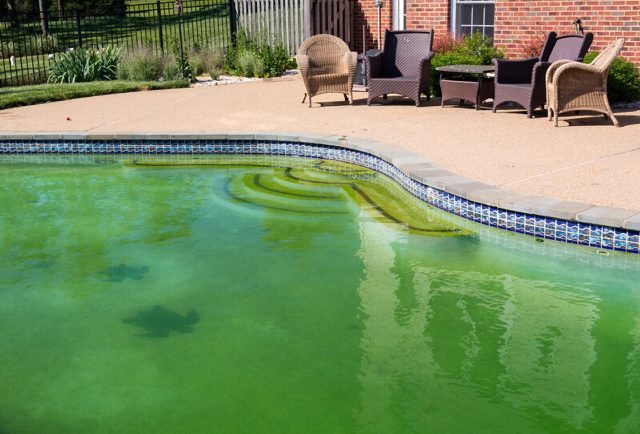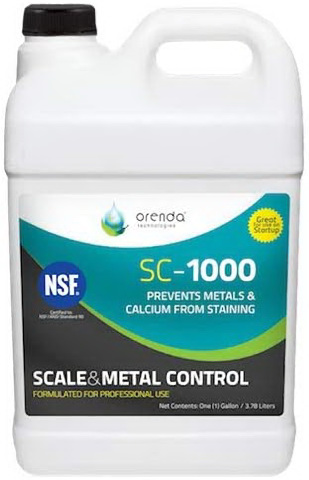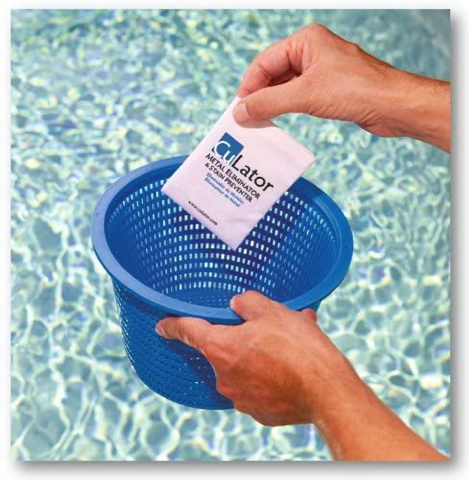Have you just shocked your pool or added a large dose of chlorine only to have the water turn green? First of all, don’t worry, it’s common for pools to turn green after shocking.
In this article, I’ll walk you through why your pool turned green after adding a chlorine shock and how to get your pool looking clear again.
Pools can immediately turn green after shocking or adding chlorine when they have metals like copper or iron in the water. These metals oxidize when exposed to high levels of chlorine, which makes the pool water turn green. Metals in the water are caused by some algaecides and using well water. Adding a metal control product will help to restore the pool water.
This may not be the only reason your pool is green after shocking though. Keep reading to learn about the other reasons your pool is green after adding shock and how to get your pool clear again.

Article Contents
Reasons Why Your Pool is Green After Shocking or Adding Chlorine
1. Recently Added Algaecide
If I were a betting man, I’d probably say that the reason you shocked your pool in the first place was that it was cloudy or you had an algae problem. If you did treat your pool with an algaecide, there’s a chance this has actually caused your pool to go green and the algaecide didn’t clear it up like you hoped.
There are a few different types of algaecides that contain various chemicals to suppress and fight off algae. Many of them include copper or copper sulfate. It’s this copper that oxidizes in the water. And when copper oxidizes it turns a green color causing your pool to look green.
Adding a shock treatment or a lot of chlorine at the same time as a copper-based algaecide will speed up the oxidization process. Your water may in fact almost instantly turn green.
How to Fix:
Use a metal control product that chelates the metals is one way to deal with this. “Chelate” in this sense is to bind the metals. This product binds the metals but will not remove the metals though.
Here’s a metal chelant:
- Environmentally friendly product, suitable for pools & spas
- Prevents metal staining and scale formation
- Reduces calcium scale in pool heaters & chlorine generators
To actually remove the metals you’ll need CuLator. CuLator is a product that will remove metal ions from the water.
CuLator will remove metals:
- Removes copper, iron, manganese, cobalt, nickel & silver
- Works for pool & spa water
- Traps metals in the bag & takes them out of the water
2. Cyanuric Acid (stabilizer) Too High or Too Low
If you’ve used a chlorine based shock product, and you still have algae, or the water turned green after using it, another reason is that the levels of cyanuric acid (pool stabilizer) were too high or too low.
Pool stabilizer is either added to the water separately as cyanuric acid or it comes as an additive in some pool chlorines like dichlor or trichlor. Pool stabilizer will protect your outdoor pool’s chlorine from the sun’s UV rays. UV light destroys or degrades unstabilized chlorine.
Without stabilizer, when your pool is exposed to sunlight, all that pool shock or chlorine you added will degrade in a matter of hours and will not have the algae-killing effect you hoped for.
Saying that, too much stabilizer is also a bad thing. The higher the stabilizer levels, the longer it takes chlorine to kill off bacteria and algae. And if the chlorine is taking too long to kill the algae, it may be why your pool is green after shocking.
How to Fix:
Before you add pool shock, check that your stabilizer levels are correct. Do not skip this step. The ideal level of stabilizer is 30-50 ppm. Stabilizer levels over 80 or 100 ppm will significantly slow down the chlorine. Levels lower than 30 ppm will mean the sun will break down the chlorine faster than it can kill the green algae.
If your stabilizer levels are too low, it’s a simple fix. Go and grab some Cyanuric Acid. Sometimes called Pool Stabilizer or Pool Sunscreen or CYA. Follow the directions and add it to your pool.
Here’s a pool stabilizer that I recommend you use:
- Stabilizes & protects chlorine from UV degradation
- Since it's liquid, it takes effect quickly
- Suitable for pools & outdoor hot tubs
If your stabilizer levels are too high, this is a little harder to deal with. Stabilizer doesn’t evaporate or get used up. It stays in the water. So the only way to get it out is to partially drain your pool water and then refill it. This will dilute it and reduce the levels.
Further Reading: Cyanuric Acid for Pools – The Complete Guide for Pool Owners
3. Not Enough Shock or Chlorine Was Added
Usually, adding pool shock is the way to deal with algae or clear up a cloudy pool. However, if your pool is particularly cloudy or has quite a lot of algae, then it’s possible that you didn’t add enough shock to remove the algae, which is why your pool is still green after shocking.
How to Fix:
If you need a powerful pool shock pool shock, I recommend cal-hypo. You can get it here:
- Powerful pool chlorine/shock treatment - great for killing algae & everyday chlorination.
- It can be used in all pools & doesn't raise stabilizer levels
- Clears cloudy & dull water
To kill off algae and get that water clear again you need to maintain a chlorine level of 30-50 ppm. Test your water after adding the shock and then again the next morning after adding the shock or super dose of chlorine. If your chlorine has significantly dropped (more than 5 ppm), then you need to add more chlorine or shock.
This is because the algae or bacteria present can use up the chlorine at a faster rate than you can add it.
Keep topping up the chlorine/shock until your chlorine doesn’t drop significantly overnight. It may take several days of adding chlorine to achieve this.
4. Pool Needs More Filtering
Green pools can take time to clear them up and one area where people fall short is not enough filtering. If you’ve just added pool shock and the pool is still green, turn that filter on and leave it running.
Running your filter for 4,6 or 8 hours isn’t enough. You need to get the algae and other organic matter out of the pool and into your filter.
How to Fix:
If you’re trying to clean up a green pool after shocking, you want to run that filter for 24-48 hours. Or possibly longer. Running the filter will cycle all of your pool water through it and pick up algae and other contaminants. It’s these contaminants that can cloud your pool or make it look green.
Make sure that you also clean your filter. If your pool is particularly green, you will need to clean your filter every 12-24 hours to remove algae.
Further Reading: Here’s how to clean your pool filter.
How Long Should I run my Pool Pump After Shocking?
5. Walls of Pool Weren’t Brushed Thoroughly
Shocking your pool alone may still leave your pool green. Unfortunately, shocking isn’t a set and forget algae removal method.
As mentioned earlier, after adding pool shock, you’ll need to maintain a chlorine level of 30-50 ppm and run your filter continuously for 24-48 hours.
The next thing needed is a bit of manual labor. The walls of the pool will need to be scrubbed with a pool brush. Algae growing on the walls and floor of your pool can be more difficult to kill.
When it grows here, it forms a protective coating making it hard to get rid of. The best way to deal with this is to scrub it off and let the filter remove it.
How to Fix:
Grab yourself a metal bristle pool brush (if you have a concrete or plaster pool) or a nylon bristle pool brush for liner or fiberglass pools.
Connect it up to the pool pole and get scrubbing. You’ll need to be quite aggressive. When you do this, first clean your pool filter to remove any caught algae, then switch it back on. Running your pool filter will catch the algae you’ve removed.
Here’s a metal bristled pool brush suitable for concrete pools i.e. plaster or gunite or tiled:
- Specifically designed for gunite / concrete pools
- Stainless steel bristles effectively remove stubborn algae stains
- Die-cast aluminum back & handle make it strong & durable
Here’s a nylon bristled pool brush which is suitable for fiberglass and vinyl pools:
- Perfect for vinyl or fiberglass pools.
- 17.5" extra wide head for fast cleaning
- Nylon bristles for gentle yet effective removal of algae & other scum
6. Pool Filled with Well Water
We just talked about the copper in copper-based algaecides oxidizing and turning green. There is another way you can get metals, like copper or iron, in your pool water. And that is your water source.
Well or bore water often contains much higher levels of metals than water from your city supply. As well as metals, well water can contain minerals like magnesium, sodium and calcium. It can also contain nitrates and nitrites, as well as heavy metals like copper and lead.
If your pool water is from a well or bore then it’s likely it contains some metals and they may have oxidized after you added pool shock and turned the pool green.
How to Fix:
You may be able to use a metal control product again. One that chelates the metals or a metal sequestrant. In addition to this, you may need a metal removal product or to even partially drain your pool and fill it with water that contains fewer metals.
Metal sequestrant to control metals:

Click here to check the price >>
This product will remove metals from your pool’s water:

Click here to check the price >>
7. Phosphates in the Water
If you’ve tried some of the other tips and they weren’t responsible for your green pool, phosphates could be contributing.
Phosphates are artificially made and are also a naturally occurring chemical compound. They can be found in rainwater runoff, fertilizer, bird droppings, food, and cleaning products. Our bodies need them to survive.
Having an overload of phosphates could be giving algae additional food. They’re actually a superfood for green algae. Phosphate levels in pools should be kept below 500 ppb (that parts per billion).
You can find out the phosphate levels in your pool water by taking a sample to your pool store for testing or you can get a phosphate test kit.
Here’s a phosphate test kit:
- Keep phosphates in check & prevent algae
- Quick & easy way to test & monitor phosphate levels
- Accurate results
How to Fix:
There are phosphate removal products. Some people love to use them and others don’t think they are necessary. If you maintain your pool chlorine & other chemical levels correctly, filter the water enough and have a great pool cleaning routine, then you really shouldn’t have a green pool.
However, if you would like to try a phosphate removal product, give this one a go:
- Controls & eliminates phosphates in spas and hot tubs
- Works in most pool water but ideal for spa saltwater systems
- Protects against calcium phosphate scale build ups
8. pH Level Incorrect
An incorrect pH level is another cause of having a green pool after shocking it or super chlorinating it. If the pH level is too high, then the shock will not be effective.
There’s a direct relationship between the killing power of chlorine and the pH level of your pool. Usually, pH of a pool is maintained at 7.4-7.6. This is the level that will be most comfortable for swimmers and will not irritate eyes.
At a pH of 7.5, chlorine is actually only about 50% effective. And at 7.6, it’s about 40%. If you shocked your pool and the pH level was 8, then the chlorine is down to only 24% killing power! It’s for this reason that it’s vital you have your pH level correct before shocking your pool.
How to Fix:
If you didn’t test the pH level or suspect it was high before you added the shock, then you’ll want to reshock your pool. But before you do, this time you’re going to adjust your pH level to 7.2. It’s a little lower than the ideal range, but it will mean the chlorine will be 63% effective. That’s a lot more algae-killing power!
To lower your pH level, add sodium bisulfate or muriatic acid. To raise, soda ash or baking soda is usually your best bet.
Further Reading:
How to Lower the pH in your Pool
Low PH in Pool: How to Raise
Final Thoughts
To sum up, the main reason your pool is green after shocking it is that there may be copper in the water that has oxidized. Additionally, if you didn’t add enough shock, the pH level or cyanuric acid levels were incorrect, or you didn’t run your filter long enough, your pool may still be green.
Focus on getting your pH and cyanuric acid balance correct first. Then make sure you have high levels of chlorine to kill the algae whilst continually running the filter for 24-48 hours. If you do these things, you’ll quickly turn your green pool water to clear!









